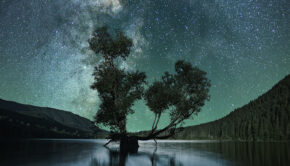The Organic Torah of Hanukkah: An Emerging Holiday
I often hear people say, “Hanukkah is actually a minor holiday.” I think people say it because it is embarrassing that Hanukkah is the most celebrated Jewish holiday in the U.S., and it is so clearly because of its proximity to Christmas. But I don’t think Hanukkah is a minor holiday. It is an emerging holiday, and it has been emerging for thousands of years. It is the holiday that best shows us the organic quality of torah.
We have a word for this emergent and self-organizing dynamism: life.
Life began with cells. That means, from the simplest microbe to the most complex animal there are boundaries, walls or membranes that keep enough stuff out so that the processes of life, metabolism, can occur within. It can react to its environment, it can grow and change. Those boundaries create space for a wholeness to emerge. But they need to be porous enough so that food, energy, information can go in and out. No living being is an island.
Judaism is a living tradition, and it follows the same patterns as any life form. It grows and changes. It sometimes sets boundaries against the outside, and sometimes brings in new ideas or people from the outside to increases its energy. It is a self-organizing system that can integrate change.
Hanukkah is not only a great example of how Judaism grows and changes but Hanukkah itself advertises this dynamism. It is the essence of the holiday.
When we look at the dancing lights of the menorah, we see dynamism. But more than that, the very origins of the menorah speak of dynamism. When we think of the “Ner Tamid,” the Eternal Light, we might think of the electric light above the bimah in the synagogue, but the original Ner Tamid was in the ancient Temple, it was the Menorah. And when the torah says “tamid,” the word doesn’t exactly mean eternal. It means constantly, every day, as the menorah must be kindled constantly, every day. The Greek idea of the eternal was a static entity, as in Plato’s Forms. But the eternity of the Torah is in being constantly renewed.
Digging deeper, the holiday of Hanukkah is built on an agricultural holiday which celebrates the end of the olive harvest. When they would celebrate the olive harvest they celebrated by lighting olive oil lamps, to light the darkest time of the year. The elements of trees and olive oil remain central to Hanukkah today. Even if we sometimes forget their origins, they are not lost, but keep turning up again, in different forms. Olive oil, and the light from that oil are a major part of this holiday from the miracle of the oil, to the frying of latkes.
But there is another connection to trees: the menorah itself is modeled on the shape of a tree. The great Israeli naturalist Noga HaReuveni theorized that the menorah is based on the salvia plant. Take a look at a photo of the plant here and see the clear resemblance.
The menorah goes back to the natural world and the religious meaning that people found in trees and plants which represent life and growth, fertility and continuity. Trees are long lasting — especially olive trees, which can live hundreds of years. The torah is an etz hayyim, a tree of life.
So, when the Hasmoneans achieved an unlikely and miraculous military victory over the Hellenists and the Seleucid armies and instituted a new holiday, they were building on earlier forms.
But the Rabbis were not very big fans of the Hasmoneans and their victories. They seem to have tried to avoid Hanukkah. Unlike every other Jewish holiday, it has no tractate of its own in the Mishnah or Talmud. Hundreds of years after the events the Talmud asks the amazing question: what is Hanukkah? And they give the answer of the miracle of the oil lasting eight days. The emphasis has shifted back from the military victory to the oil and the lights. Their emphasis is spiritual resistance, but the trees, the oil, haven’t disappeared. They are integrated and come back in the form of torah, of light.
But celebration of the military victory as a miracle didn’t go away in the Jewish tradition. We see it preserved in the siddur, the prayer book, with the al haNissim blessing inserted on Hanukkah in the Amidah silent prayer. This may be an indication that whereas the elite rabbis wanted to emphasize the spiritual resistance, the people never forgot the military victory. With Zionism, this aspect re-emerged as central.
Judaism has absorbed and integrated an agricultural holiday, a solstice holiday, a tree festival, a celebration of an amazing and unlikely military victory against the odds. And it is has created a rich holiday that in its essence tells of how torah is alive, like that olive oil light, constantly renewed, constantly reminding us that with courage and hope we can bring light out of darkness, hope out of despair.
The message of Hanukkah is in all of these symbols and in the organic torah that finds a balance between defending our boundaries, but also keeping those boundaries open enough to let energy and ideas in, and the self-organizing internal process of integrating all these dynamics into a rich and beautiful holiday that carries the echoes within its cells of its own growth and change, and carries forward to each generation the torah of etz chayyim the tree of Life, and miracle of light and life that can come alive from just a small spark.




4 Responses to The Organic Torah of Hanukkah: An Emerging Holiday